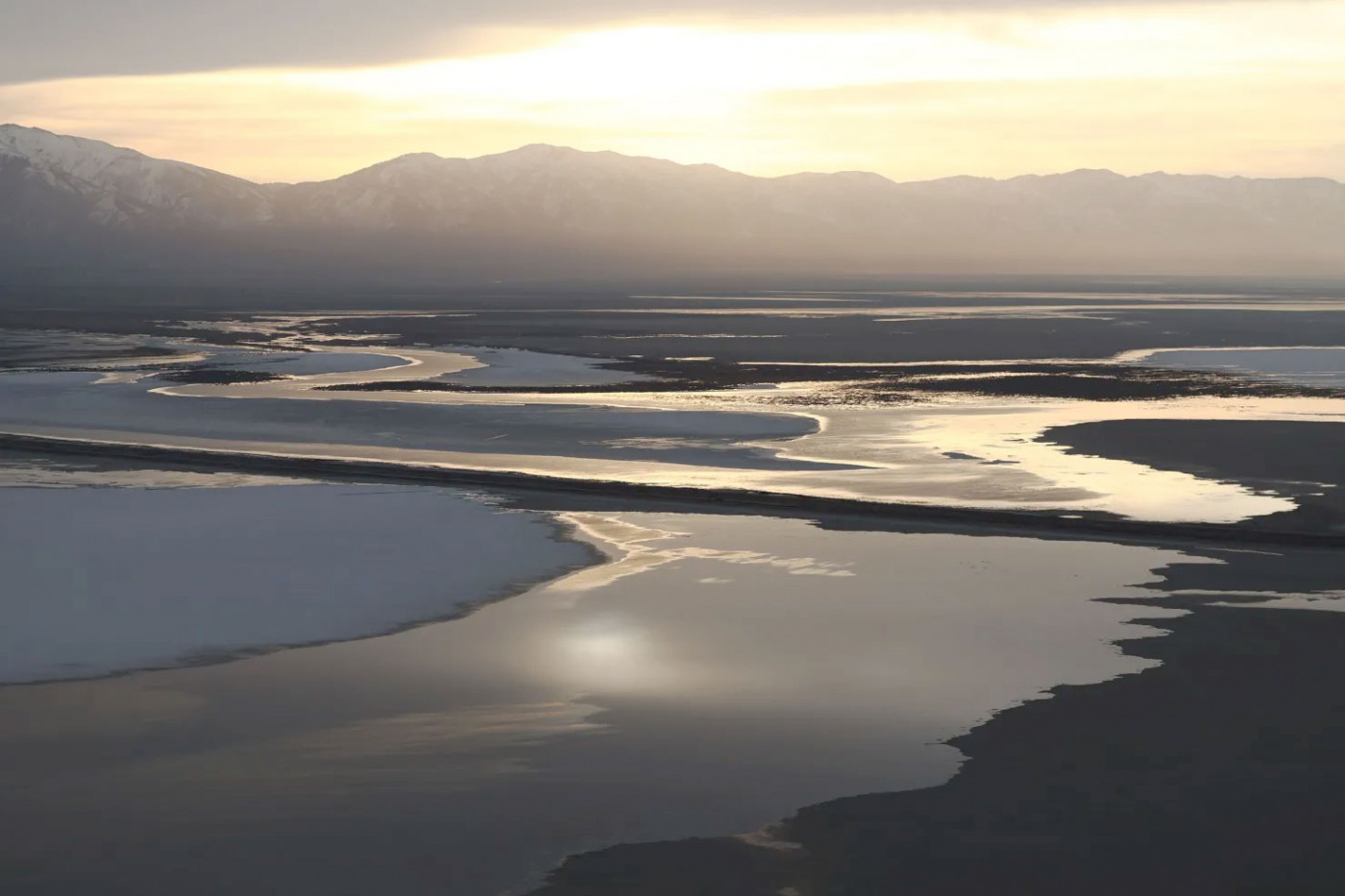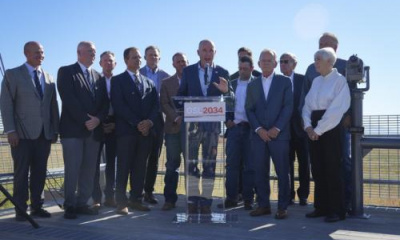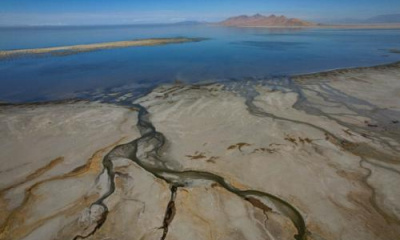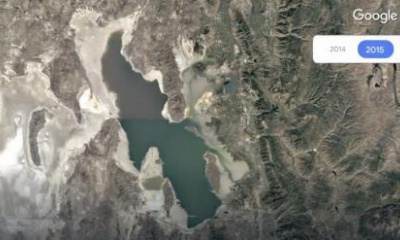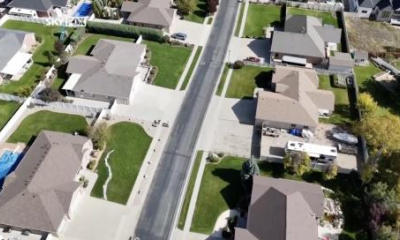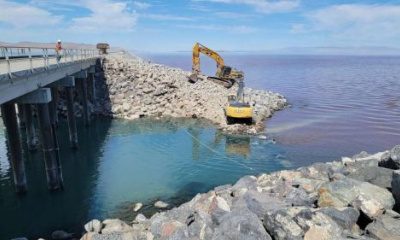Advocates, researchers and others intimately acquainted with the Great Salt Lake have watched with dread over the last two decades as it has steadily dwindled to a trickle of its former self.
Its ailing condition has been as glaring as its receding shorelines — the increases in salinity, the shallow muck-filled marina, the compromised population of birds and other wildlife.
These friends and fans have known that diversions and other human-made impacts have dropped the lake by 11 feet since pioneers first arrived in Utah.
The worst drought in North America in 12 centuries is hemorrhaging the crisis for the lake that Great Salt Lake Coordinator Laura Vernon describes as a wicked problem.
“I like to think of the Great Salt Lake as a wicked problem where there’s not one solution to getting water to the Great Salt Lake.”
She compared it to a knotted-up ball of yarn.
“You’ve got a ton of stakeholders and they all have opinions and they all have intentions to use the water that they have been receiving for years. I’m constantly trying to wrap my head around the fact that this is like that ball of yarn where you think you have found the end and you pull one string and you make it tighter somewhere else.”
In 2013, the Great Salt Lake management plan looked at varying lake levels and how those impacted the lake, its ecosystem, industry, birds, recreation and more.
Vernon said give or take a few feet, an elevation of 4,200 feet is ideal.
“We thought in a couple of years the lake level would be back up and we would be managing in that middle range.”
A new reality
That didn’t happen. Vernon said it was with growing dismay as she and others vested in the lake watched its elevation continue to decline.
“What we are seeing and starting to understand is that we don’t really see it coming back to what we originally thought was that sweet spot for the Great Salt Lake, and so now it’s kind of like looking at the lake with a new set of eyes and a new paradigm.”
The lake now has half the volume it did just a few decades ago. It hit its all-time recorded low in October of last year, with key inlets such as Farmington Bay and Bear River Bay shrinking drastically.
The ecological metamorphosis of the Great Salt Lake that has been unfolding for decades poses the paradox that the smaller the lake gets, the bigger the problems become for not only Utah, but in a global manner for conservationists, industry and others.
A study that came out 10 years ago put the economic value of the Great Salt Lake to Utah at $1.32 billion. That’s jobs, recreation, industrial activity, tourism and more. It includes the value of the mineral extraction industry or the lake’s unique global role of providing brine shrimp to fish farms, a business valued at $67 million a year.
As the lake dwindles, the potential economic costs of a failed lake are astounding. A report commissioned by the Great Salt Lake Advisory Council said low lake levels, particularly those over a long period, could result in losses totaling $1.69 billion to $2.17 billion per year and job losses of more than 6,500 positions.
The potential costs evaluated in the 2019 report include those caused by reduced lake effect snow, increased dust, reduced lake access, increased salinity, habitat loss, new island bridges and the spread of invasive species.
A dusty future
With every decrease of one foot in the level of the Great Salt Lake, 150 square miles of lake bed is exposed. That means that since Latter-day Saint pioneers arrived, more than 1,600 square miles of what once was lake has become crust that is vulnerable to wind events.
Research shows that 40% of the dust in the Salt Lake and Ogden areas comes from dry lake beds of the Great Salt Lake and that dust contains toxic elements, such as arsenic. Arsenic has been linked to a variety of cancers and the particulate matter messes with respiratory systems.
The largest source of PM10 pollution in the United States is California’s dried up Owens Lake, which many Great Salt Lake saviors emphasize as a dire problem Utah wants to avoid. California has spent more than $2 billion to mitigate the effects of dust pollution, and its fight is far from over, with ongoing millions in costs.
Like the Great Salt Lake, diversions over time dried up Owens Lake and California is left to mitigate the mess.
The dust poses problems not only for human health but for ecological health of natural systems, including alpine streams and mountain snowpack.
Greg Carling, a geology professor at Brigham Young University, is part of a five-year study funded by the National Science Foundation looking at lake bed dust and its many impacts.
Researchers already know there have been consequential impacts.
He pointed out that a single dust event in 2017 accelerated the snow melt season by one week.
“The dust darkens the snow surface and causes it to melt earlier.”
As the lake shrinks, so does its role in the unique event of winter storms that produce the “lake effect” band of snow that can pile up in the valleys. Those less frequent types of storms contribute to the perpetual cycle of drought — diminished lake, diminished storms and drier conditions.
A decimated nursery and unraveling ecosystem
A high value “nursery herd” of bighorn sheep on Antelope Island was wiped out with the brutal death of pneumonia. More than 100 animals were lost a couple of years ago.
One of the wild animals walked off the island due to low lake levels and became infected by a domesticated sheep. And just like that, a prized nursery to raise bighorn sheep for other areas was lost.
Antelope Island State Park officials have had to fence the island for the sheep and retrieve wandering buffalo.
Gunnison Island, home to one of the largest North American breeding populations of pelicans, is now vulnerable to predators like coyotes and the red fox because they can just walk on in.
“They can come out there and decimate those populations,” said John Luft, Great Salt Lake Ecosystem coordinator with the Utah Division of Wildlife Resources. “So there’s some difficulties with keeping or maintaining the lake levels where you actually have islands now that are all peninsulas. There’s actually no islands on the Great Salt Lake anymore.”
The effects stretch beyond land-based wildlife, posing threats to a unique shoreline sanctuary for birds.
An estimated 10 million birds, representing 330 species, rely on the Great Salt Lake and its wetlands for breeding, staging, and in some cases, as a winter destination.
The lake is recognized as a site of “Hemispheric Importance” for shorebirds by the Western Hemisphere Shorebird Reserve Network and is a crucial part of the Pacific Flyway — akin to an international interstate for feathery world travelers. It is among 107 sites in 17 countries covering 38 million acres in the network.
Bird-watching enthusiasts come from around the world to visit the Great Salt Lake and document its extensive array of migratory birds.
“For those of us who spend a lot of time at Great Salt Lake and watch the birds, we see how low lake levels, the spread of phragmites, the loss of habitat and food resources transform large swathes of habitat from year to year. With the historic low lake levels, diving ducks and Eared Grebes shifted to deeper water areas on the lake this last year. Birds are more concentrated in some areas, and completely absent from others,” said Max Malmquist, outreach associate for the National Audubon Society’s saline lakes program.
Malmquist said he witnessed hundreds of acres of habitat grow dry at the Willard Spur, an area normally teeming with birds.
“The birds so far have been resilient, and are able to move to suitable areas around the lake, but I am always concerned about what will happen if we continue to lose habitat — locally at Great Salt Lake and throughout the region. How resilient can they really be?”
Decimation of lake levels is also threatening the very lungs of the Great Salt Lake, home to one of the world’s largest modern accumulations of living rocks known as microbialites.
These are underwater reef-like mounds hosting microbes that use photosynthesis to bring the sun’s energy to the lake and provide a landing spot and nutrition for the food chain that supports the entire lake. They are drying up, just as the lake is.
The result? The base of the entire Great Salt Lake ecosystem is threatened since the microbialites serve as a primary food source for brine shrimp and brine flies. As they go, so does the rest of the system.
Come sail away
The Great Salt Lake once had a thriving, close-knit sailing community. Low water levels have chased the majority of boaters away.
Dave Shearer, manager of the Great Salt Lake State Park and harbor master, said there are 14 boats in the marina and another 150 in storage or the parking lot. The marina has a capacity for 300 vessels.
In response to low lake levels and the buildup of sentiment, the marina was dredged five years ago, but declining lake levels have once again rendered it practically unnavigable.
The hit to sailing is a blow to Utah’s recreation economy and another lost opportunity to enjoy the lake — or what is left of it.
Shearer said the compromised marina also means compromised public safety response.
Years ago, he lamented that one of his greatest fears is that if a plane were to crash over the Great Salt Lake, the ability to quickly carry out rescue attempts would be lost because the water would be too shallow to launch the state’s search and rescue boat.
“I am afraid by this summer we will not be able to operate current search and rescue boats,” he said. “There’s still recreation to be had, but people have to realize help will be coming from farther away from Promontory.”
The Promontory marina is about 35 miles from the Great Salt Lake Marina, and currently no search and rescue boat is staged there, Shearer said. There is a rescue vessel at Antelope Island.
“We have some serious challenges.”

